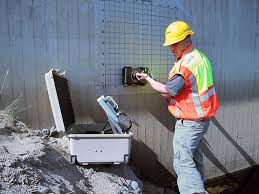Concrete GPR and Corrosion Detection
Concrete GPR and Corrosion detection are performed to detect rebar inside hard concrete and the corrosion of reinforcing steel in a concrete structure. Normally a corrosion scan is done to check the reinforcing condition in a building slab, beam, column, or other structural members during a structural condition assessment of the building. As part of the structural integrity reserve studies as mandated by the new Florida law SB-4D or milestone inspections phase two, the corrosion extent and damage caused to concrete or steel structures are detected using highly advanced corrosion equipment, which can check the rebars deep within the concrete.
EMA provides concrete GPR Scans to detect reinforcing steel or Post tension Cables in Palm Beach, Fort Lauderdale, Orlando, Tampa, Sarasota, Clearwater, St. Petersburg, and surrounding areas our engineering staff uses state-of-the-art equipment. We can locate rebar and post-tension cables within the concrete. Reinforcing steel locations are marked directly on the concrete surface to ensure safe and efficient drilling that will preserve the integrity of the structure and reduce the need for repairs or patching. This helps our clients conduct core drilling without accidents, injuries, or delays. Concrete PT Cable detection GPR Scan is also useful when preparing for a renovation that includes electrical outfitting, plumbing, fire protection services, drain installation, and ductwork.
Concrete GPR EMBEDDED ELECTRICAL SERVICES
When core drilling or saw cutting in commercial and industrial locations is needed, accurate detection of electrical conduits is essential for preventing safety risks, power outages, and costly damages. Concrete GPR Scan for PT Cables Daytona provides two specific but different scanning services in this area: Elevated concrete slab scanning and concrete slab-on-grade locating. Elevated concrete slab scanning involves detecting embedded electrical conduits before core drilling a hole through the slab.

Concrete slab-on-grade locating – a concrete slab poured directly over dirt – involves scanning a trench line for conduits before conducting saw cutting and trenching to install all a sanitary pipe, water line, or, something similar.
Concrete GPR and Corrosion Detection using MIRA
The MIRA concrete tomograph performs reinforcing corrosion detection and represents a revolutionary approach to concrete ultrasonics. The best way of describing its capabilities is by analogy. It is the construction equivalent of ultrasonic scanning in the medical world. Capable of void detection for flaws as small as 30 mm at 400 mm depth the MIRA can also measure slab thickness, test tile or panel bond, confirm grouting behind panels or in post-tension ducts, and is the only system that can measure cover in steel fiber reinforced concrete. The Mira is not one new technology. It is many new technologies seamlessly combined to create a truly revolutionary concrete investigation tool.
The Ultrasonic Transducers are only 2mm diameter
This is made possible through the use of side scanning shear wave emission technology developed by ACSYS’s side-scanning. Conventional ultrasonic equipment would typically use 50mm diameter transducers to produce compression waves.
The Ultrasonic Probes require no coupling gel
Drypoint contact transducers mean that instead of having to use coupling gel to ensure the transmission of waves into the concrete as in standard ultrasonics. The probe can be moved from position to position with next to no surface preparation.
The use of a multiple array of probes in one head
Only possible because of the small ACSYS probe’s specially designed spring mounting to ensure uniform contact. This enables around 100 pulse-echo ultrasonic results to be obtained in under 2 seconds with each scan. Hence readings are taken at close (30mm) spacing. Typically ultrasonic measurements in concrete are taken one at a time at 500mm centers in order to make processing manageable.
The software builds 3D sectional images of the concrete’s internal geometry
These images can be played as if the viewer were traveling through the concrete, displayed as any section through the concrete, or 3D scans can be used to show progressive sections through the concrete.
The software builds 3D sectional images of the concrete’s internal geometry
The photo to the left shows a typical post tension post-tension cable mark out. Using GPR and other data, we can locate all of the reinforcing steel anomalies. We then mark the findings on the concrete and, based on the pattern, are quickly able to determine what each marking indicates. Most often, when something is on an angle through a square layout it will be a conduit. You will have a typical rebar pattern with 12-to-18-inch centers. Post-tension cables tend to be spaced further apart, depending on the building’s design and whether they are banded or uniform tendons.
